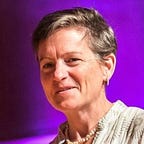Healing Trauma: Creating a virtual experience grounded in complex reality
Alayna is a 15-year-old girl in deep conflict with her mother, Dee. When the conflict escalates, Dee throws Alayna out of the house and the teen lands in a group home. For the caseworker assigned to this case, Alayna can be challenging. Hurting and afraid, Alayna exhibits the hallmarks of argumentative and defiant behavior. Her attitude and sharp tongue could trigger even the most patient person to anger. And yet, we know that anger isn’t what Alayna needs.
Strictly speaking, Alayna isn’t a real person. Our team at Accenture created her and her mother to exist in virtual reality (VR) as part of the Accenture Virtual Experience Solution (AVEnueS). Even so, they represent composites of many of the people involved in the child welfare system. Alayna has been experiencing ongoing trauma. So has her mother. So have the individuals who raised Dee. Together, these characters illustrate what a growing body of research suggests: trauma has a significant impact on human development. That’s true for trauma we experience directly and for generational trauma passed down along family lines.
Children and family services agencies are increasingly training caseworkers on this phenomenon, and Alayna’s AVEnueS scenario is designed to support a critical shift to trauma-informed care. Through a series of interviews, the VR offers caseworkers direct experience with the challenges of supporting traumatized adolescents. It also offers an opportunity to reflect on how to create healing environments for young adults like Alayna.
As we were developing the VR scenario, we wanted to ensure that Alayna was as close to “real” as possible. We needed to ground her in the complexities and difficulties that kids like Alayna face every day.
Bringing Alayna to (virtual) life
To develop Alayna and her story, we leaned into a group of former foster youth — individuals who have walked in some version of Alayna’s shoes. Over a series of workshops, they generously shared their perspectives and feedback to help ensure that Alayna’s circumstances, feelings, questions, challenges and reactions were true to life.
The panel of advisors included 29-year-old Dijohn Thomas. He and I connected, literally and figuratively, in 2008. I was the director of the child welfare agency in Baltimore, Md., at the same time that he was a young man in foster care. We’ve stayed close since then. As a child and teenager, Dijohn was a vocal advocate for himself and others through youth advisory. I knew he would offer candid, spirited and heartfelt input as we created the character of Alayna. He did not let us down.
“I’ve dealt with a lot of the same things Alayna is going through,” Dijohn says. “I wanted to shape her story in a way that was ‘real life.’ We wanted to make sure Alayna would have a chance to ask the hard questions and caseworkers would be able to go through difficult situations with her.”
Dijohn believes the VR scenario provides an important look at what life is truly like for traumatized youth. He also believes that nothing in formal education can fully prepare a caseworker to deal with these kinds of complicated, nuanced situations.
“Kids like me and Alayna — we can see through the standard scripts,” he explains. “All social workers say the same thing: ‘I’m here to help. I’m here to offer you services. We’re going to help you develop coping skills.’
“For a lot of kids in foster care, those are trigger words. They tell us that you don’t really care, that it isn’t personal for you.”
What they want (and need) instead: personal interactions. Personal investment in their lives. In short, Dijohn explains, “We need to know that our caseworker is going to be there for us now that our parents aren’t.”
Experience of emotion
Dijohn and I have both donned the Oculus headset to interact with Alayna — and we both had profound, visceral reactions.
“It’s heartbreaking to sit with a child whose mother has told her ‘I just don’t want you,’” he says. “There’s nothing you can do about that. As the social worker, you’re trying to calm the kid and make sure they’re all right. But the truth is always looming, and Alayna is sitting in front you asking, ‘What are you going to do? How are you going to help me?’”
Dijohn told me the experience stayed with him as he continued to contemplate Alayna. He kept thinking about what he said to her, what he might have done differently, how best to guide her toward healing. For me, the VR scenario is a stark reminder that age 15 is much closer to age eight than it is to age 21. Alayna is young and she’s hurting. She needs someone who will sit with her in her pain, see beyond her tough, obstinate exterior and offer her a ray of hope and the assurance of support.
There’s no fast, easy and happy ending in the VR scenario. The same is true in life. Providing trauma-informed care is long and hard work. But the kids are worth it. When we focus less on compliance and more on compassion, together we can guide the Alaynas of the world to a brighter, healthier future.
Molly Tierney is a Managing Director and Child Welfare Industry Lead in Accenture’s North America Public Sector Practice, where she leverages her 25+ years of expertise to enable states and cities to improve outcomes for vulnerable citizens. Prior to joining Accenture, Molly spent almost 10 years as the Director for the Baltimore City Department of Social Services where she managed the City’s child welfare and public assistance programs. During that time, she did a TED Talk focused on foster care.
Copyright © 2022 Accenture. All rights reserved.
